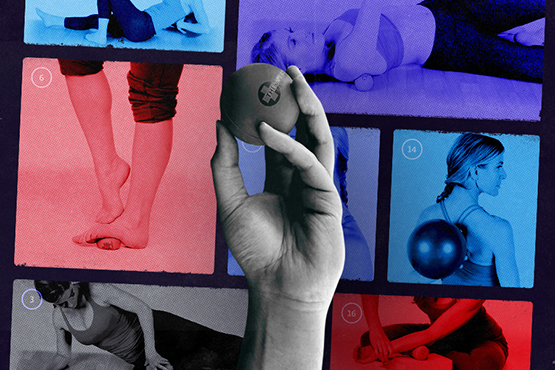
Self-Myofascial Release Techniques Using Massage Balls: Your Guide to Self-Massage
If you’ve clicked your way to this article, chances are you’re searching to soothe aches and pains, gain range of motion in your joints, enhance performance in your sports activities or weekend hobbies, or seek medication-free ways to improve your emotional resilience.
This article provides you with step-by-step video instruction to get you on your way to becoming a self-care pro using self myofascial massage techniques with a variety of Therapy Balls. At the end of this article there are a series of videos that will have you down on the ground (or at the wall) feeling the immediate benefits of this work and these tools, but first, it will be helpful to dive into some important basics.
BENEFITS OF SELF-MYOFASCIAL RELEASE (SMFR)
Self-massage (SMFR) relieves aches and pains, enhances breathing, reduces stress and improves your posture and performance. To understand how it works, you must first understand that the body is made up of multiple layers of connective tissue (fascia) that weaves and winds its way around every part of your body’s parts, connecting (and separating) you from head to toe. If you’d like to learn more about fascia, we recommend reading our January article Understanding Fascia and the Benefits of Myofascial Release for an in-depth look at this incredible living seam system (it gets a little technical, but you’ll come out the other side feeling incredibly educated on the importance of fascia to your daily life, activities and health).
JARGON ALERT
“A fascia is a sheath, a sheet, or any other dissectible aggregations of connective tissue that forms beneath the skin to attach, enclose, and separate muscles and other internal organs.”
Massage Balls improve the slide and glide between the fascial layers which translates into ease of movement, release of tension, and reduction of discomfort. The grippy texture of our massage therapy balls work by gently locking into all the tissue layers, from the surface of the skin, to the spongy superficial fascia underneath, and further within towards deep fascia. As the balls roll along the skin, they create massive shear that heats, calms, and lengthens not only the targeted tissues but the associated tissues as well.
BEFORE YOU ROLL: A FEW THINGS TO KNOW
IT DOESN’T HAVE TO HURT TO WORK
When working with your body’s tissues, keep in mind “It doesn’t have to hurt to work.” Our tissues are soft and often under a tremendous amount of tension. Going ‘all out’ to achieve relaxation can leave you sore and bruised the following day, exactly the opposite of what you’re trying to achieve.
Research shows that the body’s tissues respond better to a soft tool that gently entices your muscles into relaxation. Harder tools tend to switch on the flight or fight response resulting in muscle bracing (contracting) to protect themselves against a threat. (1)
SELF-MASSAGE TOOLS
There are a myriad of self massage tools available, running the gamut in shapes, sizes and textures, from foam rollers to wooden balls and everything in between. With so many choices, it can be overwhelming deciding which tool is right for you.
Our massage therapy balls have a compressible inner core, surrounded by natural latex rubber and uniquely designed to grab the skin for optimal shear. They have enough give to roll over and around bony prominences, like the shoulder blades, spine and sacrum, yet are firm enough to burrow deep into multiple muscle layers. The YTU® Therapy Balls provide pressure much like a massage therapist’s thumb working deep into the tissues. The Therapy Ball PLUS are slightly larger in diameter so they cover more surface area and plunge into tissues with the accuracy of an elbow. Experiment and explore with all sizes to find the right fit.
BREAK IN THE THERAPY BALLS WITH YOUR FEET
New Therapy Balls can feel firm. A great way to develop their squish and grab texture is to first break them in under your feet before rolling the rest of your body. Place them under your feet and roll, scrunch and press down. Your feet will thank you and the balls will be well on their way to developing a soft suede-like grippy exterior.
PAIN: GOOD VS BAD, HOW TO DIFFERENTIATE
We all perceive pain differently in our bodies. Here are some key things to be aware of when beginning an SMFR practice.
‘BAD’ PAIN
It can be difficult to distinguish between pain and sensation. These are some signs that you might be moving towards ‘bad’ pain and should look to modify using one or more of the techniques below.
- Clenching jaws or hands
- Short or shallow breathing
- Tension in the entire body
- Tingling, burning or numbness
‘GOOD’ PAIN
Self-Massage (SMFR) will most likely be accompanied with some sensation, especially if you’re new to rolling. Ideally, you want to stay away from pain signals (above) but you might get curious about ‘tolerable discomfort,’ exploring your edge of sensation without tipping over into anguish. Here are some ways to know you’re moving in the right direction.
- A feeling of gentle fluidity or heat in the tissues being rolled
- An overall feeling of relaxation
- Less pain throughout your entire body
- Deeper breath with less effort
- Whole body tension dissolves
AREAS TO AVOID
While rolling is good for the overall body, there are some areas you definitely want to avoid.
- Inguinal ligament – connective tissue in the front of your pelvis
- Xiphoid process – lower part of the sternum made of cartilage
- Throat/ Trachea
- Median nerve near your carpal tunnel aka underside of your wrist
- Coccyx (tailbone)
- Sciatic Nerve – large nerve running from your low back, through hips and buttocks and down the leg
Massage Ball Video Tutorials
These quick Self-Myofascial Release (SMFR) techniques give you a taste of full body self massage. You can begin with the standing sequences or go directly to the area of need. In these videos, Jill primarily uses the YTU® Therapy Balls for reasons explained above, but if you don’t have these tools you can start your SMFR practice with a tennis ball.
Feet Forward: Massage Ball Techniques for Feet
There are 26 bones and 33 joints in each of your feet! Your feet are your foundation. As with any structure, the base is the most important part. Take care of your feet because they literally take you everywhere, and “fascially speaking,” lead to literally every other area of your body. Rolling your feet impacts all body areas “above.”
- Place toted Therapy Balls on the ground
- Press into the balls with your feet and begin to roll toe to heel and back. Switch sides
- Remove the balls from the tote and place one ball under the center of the foot, in the inner arch
- Start to sway the foot back and forth, mobilizing the ankle as you cross fiber the muscles underneath
- Roll the therapy ball to the toe mounds aka the ball of the foot and repeat the motion above, rolling the ball from side to side
- Change sides and repeat
Hand Help: Massage Ball Techniques for Hands
Almost everything is at your fingertips. With just a few keystrokes you can access anything, communicate with anyone and even have time for your favorite app. With all the typing and texting, this technique is a must do to release the unknown tension in hands and fingertips. Similar to your feet, there is a very significant “upline” effect from your hands to your wrists, elbows, shoulders neck, and even your jaw and skull.
- Place the ball on the fleshy part of your thumb
- Pin the ball down onto a chair, table or desktop
- Place your other hand on top to add pressure, breathe and press into the thumb
- Begin to pivot your hand over the ball “like you’re squeezing orange juice”
- Move the ball between the thumb and index finger and to the ‘thumb splits’, pressing down into the ball for a nice stretch
- Roll the ball under your hand, like you’re ‘kneading bread’
- Switch sides
Shoulder Boulders Begone: Massage Ball Techniques for Tense Shoulders
Driving, texting, talking, stress, and constant computer use can lead to muscle stiffness and pain. This tension can lead to headaches, backaches, jaw stiffness, eye strain and trouble concentrating. Because your body is intimately connected from head to toe, rolling the muscles of the upper back and shoulders will have an immediate effect on your neck and face. Targeting one of these areas, spreads joy to the rest. As we like to say “Work locally, act gloBALLy”.
- Lay on your back, with knees bent and place either the YTU Therapy Balls or Therapy Ball Plus in the upper trapezius (exactly where you want a friend to grab and massage out the kinks)
- Lift your hips up towards the ceiling
- TOO MUCH? Modify by taking the balls to the wall and do this routine one side at a time
- Lift your arms up over your head and towards the floor
- Shift and shimmy your ribcage and arms from side to side – play with movement
- Breathe – your breath is your barometer
- Go slow for the win
Glutes and Glory: Massage Ball Techniques for Hips & Glutes
These days we sit at our desks or drive for hours on end. When we get up from our chair or out of the car, we still carry that ‘seat shape’ with us. This sequence will get you re-acquainted with your posterior, wake up those sleepy glutes, and get you prepared for your next activity. Your glutes are your main conductor for pushing you forward through space, they are your jet pack and need to have proper and consistent blood flow, stimulation and movement.
- Lay on the floor and place a toted pair of therapy balls on the side of the hip and let it burrow its way into the flesh – breathing deeply will facilitate this
- Let the balls slowly move from the side of the hip to towards the sacrum, reset and repeat
- Contract and relax with breath. Inhale, hold the breath, squeeze the glute while pushing your knee into the ground, exhale and release completely
- Move the balls in towards the sacrum and repeat contract/ relax
- Switch sides and repeat slow roll and contract/ relax
Low Back Love: Massage Ball Techniques for Low Back
According to the American Chiropractic Association (2), back pain is the single leading cause of disability in the world and most cases are not the result of a serious condition. Do this technique daily to ward off back pain caused by excessive sitting, chronic poor breathing habits, or repetitive movement stressors such as lifting incorrectly, to help you ease discomfort and keep you moving well.
- Lay on the floor or stand at the wall, place a toted pair of therapy balls in the low back flesh between the ribcage and pelvis
- Slowly roll up and down
- Lay on the floor slightly leaning to one side
- Place the toted therapy balls so that one is supporting the side body and the other is nuzzling into the low back
- Take 3-5 deep breaths into the waist, enveloping the balls
- Contract/ relax into the balls – think mini side bend as you exhale, open and expand as you inhale
- Shift yourself from side to side, like a rocking motion
- Switch sides
Best Neck Ever: Massage Ball Techniques for Stiff Neck
Stiff neck and shoulders can be caused by high stress and many hours staring at a computer screen or looking down at your phone. This self-massage routine is the perfect way to press the reset button to downregulate your nervous system and wind down after a long day or to set yourself up for a good night’s sleep.
- Lay on the floor with a toted pair of therapy balls
- Place the toted balls at the base of our skull and on top of a block
- Flex and extend your neck, creating a nodding motion
- Create a passive nodding motion by using your feet to push and pull your body
- Slowly turn your head from side to side
- Rest on one side and make tiny circles with your nose
- Switch sides
Bonus Move: The Surprise On Your Side
One way to sooth low back discomfort and spasm is to release the side body. The obliques share an attachment with the low back, and are responsible for side bending and twisting and stabilization. Back tissues can become tired and weak from too much sitting, standing and lack of diverse movement. This can lead to back spasms and general discomfort. Targeting the obliques will help calm and stretch deep into the low back. This incredible bonus move is perfect in combination with Rolling 101 for Low Back or can be done on its own.
- Place Coregeous Ball in the soft tissue space between the pelvis and the rib cage
- You can use a rolled up blanket or small decorative pillow
- Lay over the ball using your hands as a pillow
- Inhale and hold the breath, activate the muscles by drawing the waist muscles in towards the midline or belly button
- Exhale and relax the body. Repeat 2-5 times
- Make small movements with your torso like a teeter totter over the ball to massage the activated muscles
- Inhale, hold, activate the muscles towards towards the midline
- Exhale and squeeze your pelvis towards your rib cage and your rib cage towards your pelvis like you’re trying to pop air out of the ball. Repeat 3 times.
- Switch sides
While this sequence provides a good foundation for a head-to-toe self-massage routine, if you’re interested in learning more techniques and sequences for body-specific areas pick up a copy of The Roll Model: A Step-by-Step Guide to Erase Pain, Improve Mobility, and Live Better In Your Body by Jill Miller. The Roll Model Book provides over 100 massage ball moves with additional techniques to equip yourself to create your own rollouts.
MODIFICATIONS
If you experience any ‘bad’ pain or find you need ease off the pressure, try one of these modifications
- Go to the wall
- Use two therapy balls in the tote
- Use a larger size therapy ball
- Consider using the Coregeous Ball if the smaller solid therapy balls illicit too much sensation
- Place the ball on a blanket, sofa or bed to absorb some of the pressure
- Move the ball above, below or to the side of a hypersensitive area
- Skin Roll by placing any size therapy ball on exposed skin and using a light touch, spin and gather up the tissues until you feel a pleasant pinch
- Contract and relax the muscle you’re rolling to help the muscle and its surrounding tissues soften
- Breathe. Your breath is your guide. Modify until you can breathe fully
- Stay hydrated – drink fluids frequently as you would with any form of bodywork
WHERE TO GO FROM HERE?
These videos are just the tip of the iceberg. Now that you’ve had a taste of self-massage and these easy self-myofascial release techniques, here’ are a few great next steps:
 End Notes
End Notes
-
Kim Y, Hong Y, Park HS. 2019. A soft massage tool is advantageous for compressing deep soft tissue with low muscle tension: Therapeutic evidence for self-myofascial release.
-
“Back Pain Facts and Statistics.” American Chiropractic Association Today, https://www.acatoday.org/Patients/What-is-Chiropractic/Back-Pain-Facts-and-Statistics. Accessed 01 May 2020.
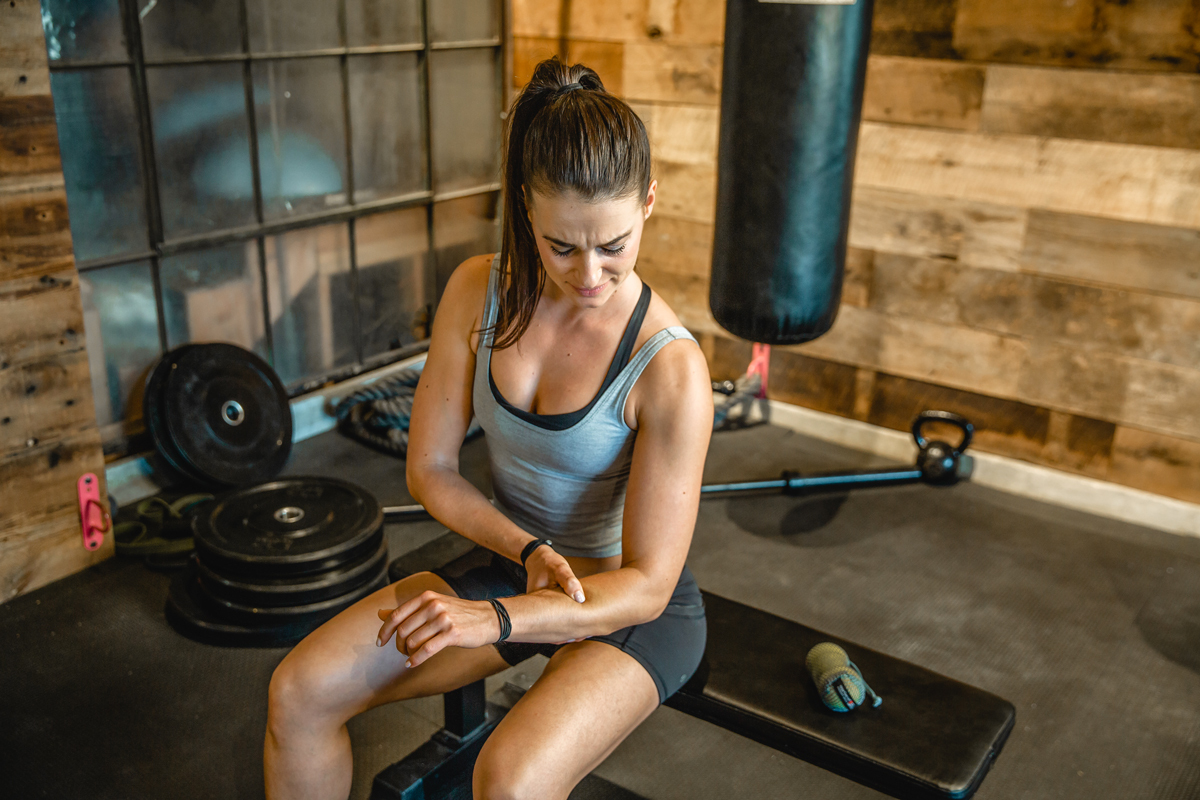
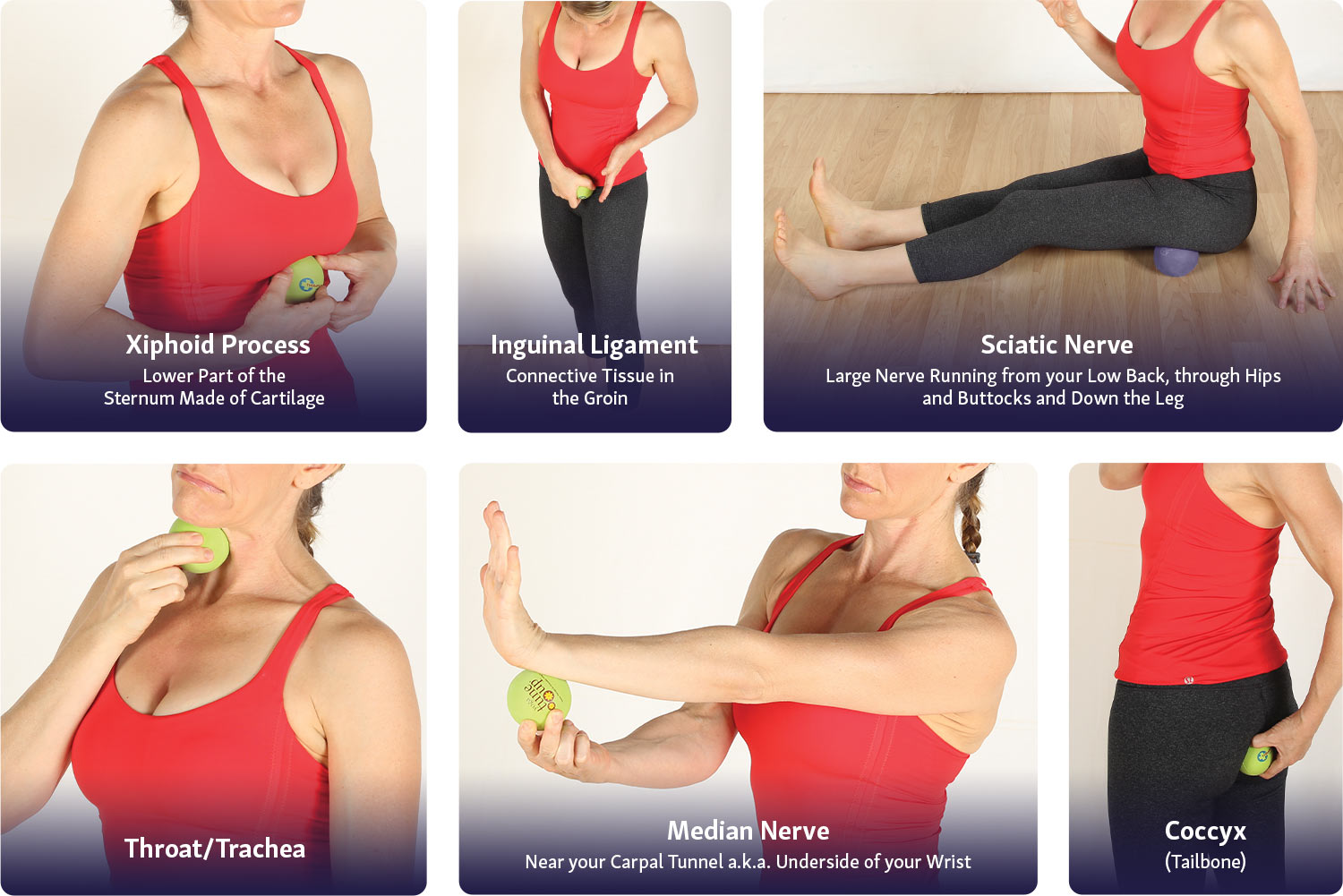
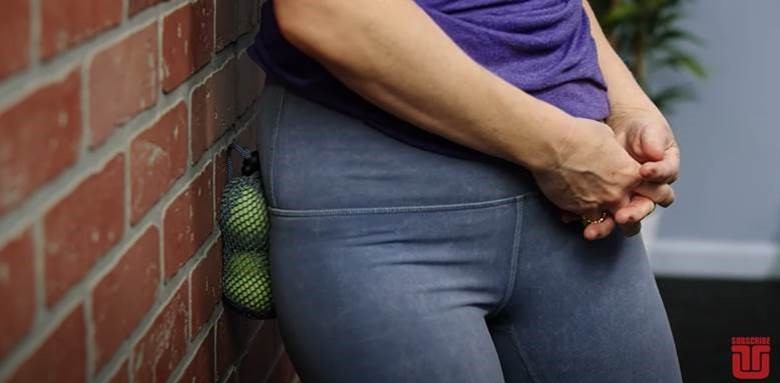


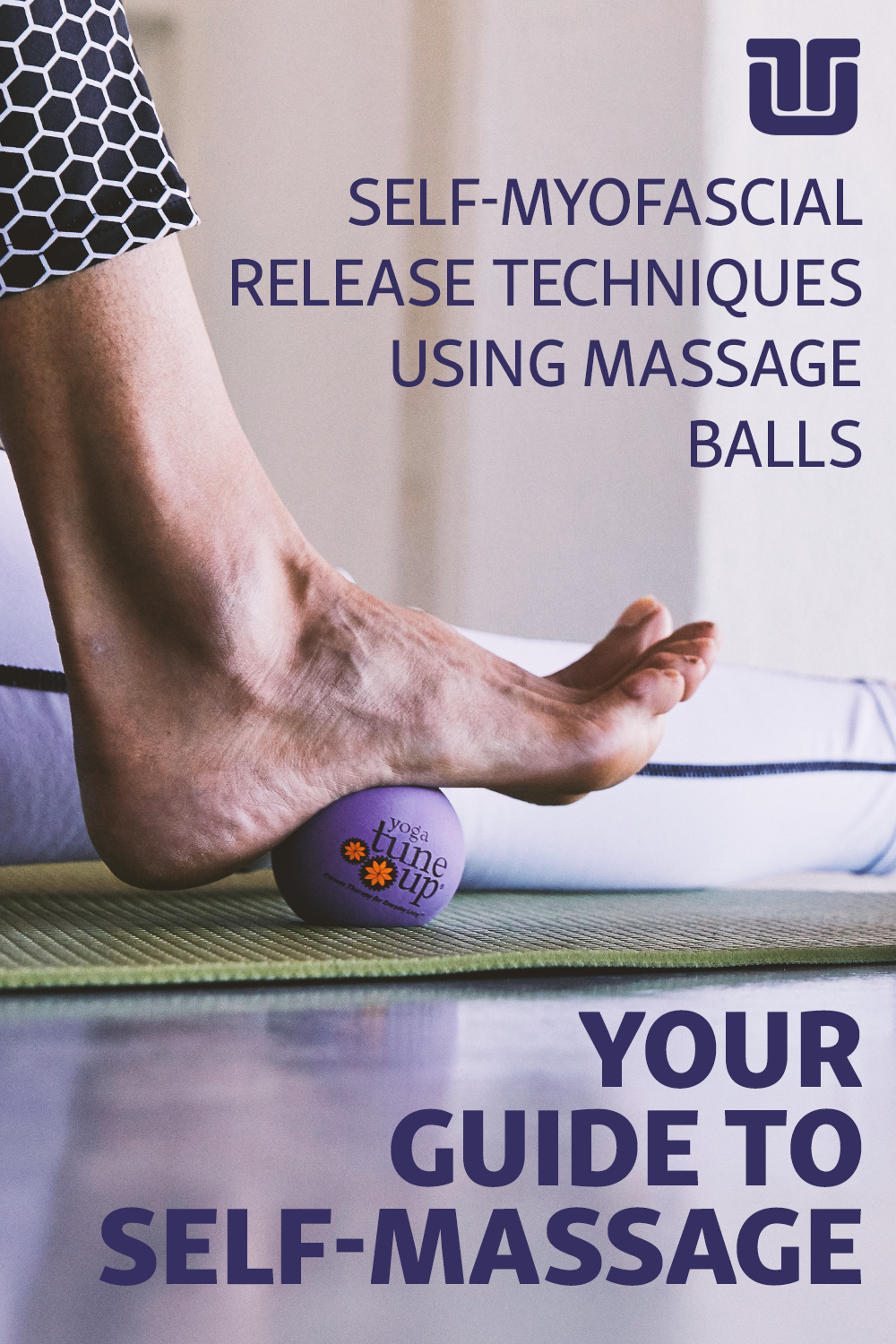 End Notes
End Notes


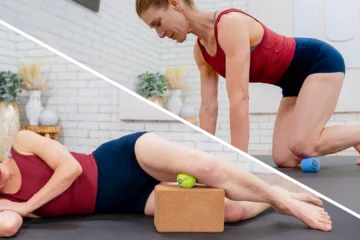








So much goodness in one article! Very empowering. I appreciate the distinction between pain and discomfort. The nuances of the line become easier to tune into with practice. And I love the clarification that it does not have to hurt! In fact, less is often more. Though the pursuit of deeper pressure for sensation is quite common, it might be a form of trauma response. In life, we often numb ourselves to various forms of intensity. Training our attention and growing our capacity to feel more with less pressure can be an incredibly healing process that readily translates to holding ourselves with more tenderness in the wider world. Om shanti <3
How can you read this & not reach for your Yoga Tune Up Balls. Do yourself a favor & get a pair!! This has been such a great tool to ease those pain points! Short & easy to follow videos for anyone to get started on their own! Love how this tools helps you retake the control of your pain.
Thanks for the article and the accompanying videos. What a great resource for everyone. I appreciate that the videos are short and to the point and target areas that are universally tight for most people. I will definitely be referring students to this website.
I love that you say “It doesn’t have to hurt to work”. I am a massage therapist and often I hear my clients say “do whatever you need to do, no pain~no gain!”. I tell them that it is possible to go deep and find relief without being in pain. Yes there is a “Good” and a “Bad” pain. I agree. I like to think of it as finding the edge, the pain that is not too much, and can still have deep breaths, comfort, and no extra tension. I think about how I often hear that “if you don’t use it~you lose it in regards to our muscles… I think of pain here, that there is pain from being a “couch potato” and there is pain from overuse. Often the underdeveloped muscles are more supple and the overused ones are more firm. Many think that the key is to dive deep and plow through with pain but that can be harmful in both cases. Finding the edge, but not taking it over the edge… with the right tools~yoga tune up balls are great and not harsh like a lacrosse ball or a golf ball. Results can happen in a delightful way! Rolling the hands and feet can be beneficial to release stagnant energy as well as help the whole limb function mor smoothly. Thank You for your expertise!!!
I’ve been using these self-myofascial release techniques with therapy balls daily, and they’ve made such a difference in relieving tension and enhancing body awareness. Thanks for the clear guidance!
Thank You Erin, I love all the tutorials and explanation on what’s unique about the Yoga Tune Up Balls and what to avoid, a great share for individuals new to SMR. A great intro.
I was initially wary of the Corgeous Ball…I wasn’t confident that it would actually “do anything”. But, the proof is in the pudding! In Body by Breath, Jill introduces several breathing techniques with the Corgeous Balls, including one of my favorites called the “lateral raphe” which requires 2 Corgeous Balls (definitely get 2 Corgeous balls…they are amazing). Before doing the exercise, she invites you lay down and 1) observe how your abdominal-thoracic breathing feels, and 2) then she asks you to flex your shoulders as far as they will go while keeping the spine in neutral. Then, to do the lateral raphe, tuck a Corgeous Ball on either side of your lower back, creating a stretch across the tissues of the back rather than a backbend. From here, begin to take abdominal-thoracic breaths, focusing on pressing your sides into the balls on the inhale and allowing the balls to sink into your sides to complete the exhale. Then, add gentle pelvic movements, anteriorly tilting on the inhale, and posteriorly tilting on the exhale. After that, check in again. See how your adbminal thoracic breath feels. Then, flex your shoulders and see if you have any more range of motion. For me, the latter was mind blowing the first time I did it. I expected my breath to be easier/deeper, but could not believe how much more range my shoulders had after doing this exercise. It does NOT have to hurt to work! I also love the hand rollout. My hands are very neglected and I NEED to do this regularly. Thanks for the reminder!
This is a helpful article to refer students unfamiliar with rolling to as a nice introduction to SMFR. One of the things that I think is really helpful is the discussion of why the YTU balls are preferable to foam rolling. Foam rollers are hard and using this tool can be painful. It is easy to imagine the muscle bracing with foam rollers! Such a great point on the purpose of YTU balls.
This was a great break down of the SMFR techniques and tools. I will definitely recommend it as a resource to students. Also, I used the videos included before a kinstretch practice and found I was able to maintain my breath more consistently.
Great refresh on Roll Model content. Although I am not currently teaching, I incorporate therapy ball techniques with some of my clients before or during assisted stretch sessions. It has been such a useful tool to me to help build their proprioception and deepen the stretch.
I found Tune Up Fitness because of chronic pain I have experienced since a car accident. I fell in love with it, and took the Roll Model Method training to deepen my understanding of working with the balls for pain management. One of the aspects I truly love about the therapy balls is the material they are made of. Foam rollers, tennis balls, lacrosse balls, and so many other tools out there are either too hard, too soft, slip, slide, pinch, and so much more. The therapy balls truly give the consistency of working with another human being because they can grip the skin and maintain pressure without becoming too rigid. I am looking forward to trying the Surprise on your Side to help with some back pain I have been having.
Another facet that I think is great from this post, is the reminder that it doesn’t have to hurt to work, and the descriptions of bad versus good pain is great context to help explain when teaching others to roll.
Thank you for such a rich, comprehensive resource. I will absolutely be referring students to this article and videos. It’s a great refresher for me as well!
As an aside – I appreciate how you emphasize that it doesn’t need to hurt to work. So many people subscribe to the “no pain, no gain” mentality. I used to be one of those people. It did take a little convincing for me to realize that the Coregeous ball could be so effective for areas other than the respiratory muscles.
Looking forward to referring to this post often!
Using the yoga tune up therapy balls in a tote on the wall in the area of my shoulders, deltoid muscles and chest muscles was a real key experience for me. This area was extremely tense and adhered. My massage result: I applied the various Roll Model Method techniques on one side first. The entire area felt new, like it had been replaced. More than just free of tension. I can’t remember I felt so good in my shoulder area and in the rest of my body. The rolling had definitely an “addictive effect” in a very positive way on me. I never be without my balls and pass my experiences and knowledge through to my clients.
It’s important to talk about pain when working on or with our bodies. Pain is not necessarily a bad thing. In fact, one can use pain as a cue to cultivate body awareness and proprioception. I prefer using the ALPHA ball for the low back massage as I find it more robust; it gives you a real ‘scratch’ for the lower back.
Love this overview on self myofascial release and massage! This article is a good resource for clients looking for refreshers on ball placement. Also it’s usually a much needed reminder to emphasize “it doesn’t have to hurt”
I so appreciate the insight “it doesn’t have to hurt to work.” For so long during stretching or rolling out I was a seeker of intense sensation – often crossing the the boundary into intolerable discomfort in the name of “making change” in my body. I believe there’s a correlation here between general perfectionism and this mentality of “no pain no gain.” What a good practice to be gentle with oneself in rolling and in life. Thank you, Jill.
What a phenomenal series! I did this sequence after a long day of bodywork on clients and discovered some body blind spots in new places. My left hand and the right side of my neck made it known I have some hidden tension. I stayed a little longer in the neck series and it relieved so much tightness. It actually is the best neck massage! This is a great series to free up the tension in your body.
This particular article gives me great reminders on how to modify the work if a patient is experiencing too much sensation in one spot. It also lays out a great explanation of the signs that someone may be experiencing “bad” pain vs what I call “therapeutic discomfort”.
What a nice overview of self myofascial release. There’s always room for a couple of small balls in a suitcase to counteract travel tightness.
I’m looking forward to doing this video sequence before bed tonight. I am a longtime student and teacher of yoga, and a big believer in getting extra help in awakening the many parts and layers of our bodies and inner selves. The Yoga Tune Up balls are like an extra set of hands and eyes, helping to illuminate where we hold tension and also to relieve it. Very exciting to delve into this practice and notice how it helps all of the other movement I love to do. Thank you Jill!!
And the best part is, the balls are portable, so we can treat ourselves in any environment – the car, at work, on a plane, while traveling… once we learn how, self-myofascial care becomes as routine as brushing teeth every day.
If we were all taught these simple, yet so effective, self-treatment techniques, how much more successful our society could be in pursuing active, pain-free lifestyles.
Great article! I appreciate the “It doesn’t have to hurt to work”. I’ve been using YTU balls since 2017. Although I had the Corgeous ball as well as the solid balls, I used the solid balls almost daily but only to compress, strip, & crossfiber until a few months ago. I had looked up a few things in the Roll Model book but didn’t go through the whole book. I was looking for the myofascial release that you get from massage therapist’s thumbs or elbows because that’s all I thought I needed. Since reading both Body By Breath & The Role Model books in the past few months and trying all of the exercises I now use all of the Roll Model Method techniques and all of the balls including the Corgeous. It is amazing how the gentle Corgeous ball moves layers of fascia, releasing adhesions.
Merci pour cet article et toutes ces techniques de balles. Plus de gens auraient intérêt connaître les bienfaits de l’auto massage. Personnellement je ne peux plus m’en passer et j’ai hâte de parfaire mes connaissances avec la formation en novembre!
Les balles c’est merveilleux ! Que de bienfaits !
Les balles m’ont permise de lever mes douleurs d’épaules en 2 jours de formation avec Mimi et Julie ! Un grand merci à vous !
Elles ne me quittent plus, je me masse quasiment tous les jours !
Thanks Erin,
Great article. I wish we could send this article to every HR work place website and somehow force them to get this information to their workers. I worked at a desk for years, in pain. Luckily, by accident, I met YT instructor in my leisure time. I quickly realized how little I knew about my body. And how little I knew about how to relieve pain in my body. It’s so empowering to get to know my body parts and learn which areas need the most care. Thank you for the work you do!
Grâce à Mimi Martel et Julie, j’ai découvert la pratique d’auto-massage des balles que je pratique presque chaque jour. C’est merveilleux !
J’adore…les bénéfices de l’automassage sont fantastiques. On peut se faire du bien sans se faire mal. Avec la pratique, on apprend à doser et à adapter nos exercices d’automassage et prendre la bonne balle pour nous. Merci pour les exercices. On peut être autonome dans notre guérison.
I really don’t know how The Roll Ball method isn’t employed at every office or by anyone that works at a desk. Such a relief to have these tools, as well as getting to know your body better!! Thank you for this article.
I have been using the Role model technique for quite some years now and I can’t stress how much it has worked miracles on my body. From back injuries to knee problems, planterfaciatus and the list goes on, the results I’ve gotten from rolling while recovering from injury has allowed me to continue to persu a career in dance.
I really appreciate the differentiation between bad pain and good pain. I think these cues will be beneficial especially for those stuck in the mindset that touch needs to hurt in order to work.
This article is a great place to send clients for a small taster of rolling vids all in one place!
I love how this blog gives a nice taster of each main muscle group/area. I know many people who know me know I carry balls everywhere, but I know that there an equally present number of skeptics. I look forward to referring to this particular blog post when short on the time I have to work through some poses with a newbie, a skeptic, or anyone who shows interest when time is short. I like the simple, general population cueing today. Thank you, I look forward to putting this into action with myself and others!
I think everyone should learn how to do self-care/maintenance on their own bodies to relieve their pain. Thank you for sharing, as I know many people will benefit and can use these self-myofascial release techniques in between visits to their soft tissue therapists. The great thing about it is you don’t have to spend a long time rolling in order to feel better right away as daily maintenance can prevent injuries and optimize performance.
Having the step by step instructions and the videos are very helpful. A great reminder to be conscious of the siatic nerve as I started out just rolling wherever it felt good, and catching the ball there did not feel good at all. Same with the Inguinal ligament, rolling over this area was beyond the edge I was looking for at that time and actually cause me to constrict even more rather than relax.
Looking for help with Plantar Fasciitis, right IT band and a very sore elbow. Thanks
This article is a definite go to for anyone interested in experiencing their “first taste” of self-myofascial massage. There’re numerous tools and techniques out there, and Tune Up Fitness has certainly outdone others by putting all these information together in a blog post. This is exactly why I chose Yoga Tune Up Therapy balls, the vast amount of education about the techniques and products are readily available and they have empowered me to take control of my own self-care. Thank you Erin and good job Tune Up fitness!
Loved this article and videos with the emphasis on “it doesn’t have to hurt to work/good pain vs. bad pan”. So important especially working with beginners and/or helping people reframe their mindset about self-care and self massage. Thanks Erin!
This blog is great because it shows you so many different variations using the yoga tune up balls. I especially like the Surprise at your Side for addressing back tightness. This is a good reminder how everything is connected and it is such a gentle way of dealing with with back discomfort. The concept that the body will recoil from objects that are hard totally make sense and using Items that are gentle to our body are so much more comfortable and it’s so much easier to be consistent
Erin, such an excellent summation of the tools, benefits, contraindications, and techniques! Especially enjoyed your focus on “good” and “bad” pain — it is of paramount importance that we teach this lesson in the fitness world!! No pain IS gain.
What a great introduction to rolling the entire body. It’s very helpful to explain good vs bad pain, as many people lack the proprioception or body awareness to differentiate.
Thank you very much, Erin, for this text which states at the outset that pain is to be avoided and which formulates the real benefits of SMFR. The videos and explanations clearly demonstrate the local work to be done in different parts of the body…for a global effect!
Good advices to begin and to take charge of our health!
So much great information! The videos are so helpful very informative!
Love all of these tools and the Roll Model Method!
I have most of the balls you describe, but not info on how to use them…
Great topics!
My physiotherapist gave me my first massage balls as rolling on tennis balls didn’t relieve the tension in my back and shoulders. I fell in love with those balls and ended up acquiring the Roll Model Guide and all the different sizes of massage balls. I feel much more empowered to take care of my own health than to avoid dealing with tension or depending on health professionals to relieve it. Thanks for sharing!
I’m looking forward to getting some tune up balls and finding out more to help my myofascial tight areas.
Thanks, Erin
Such a great valuable advice share in an Article.
This article is really a nice ”get started” post to ”get rolling”.
I enjoyed watching the videos showing the different uses of the different types of balls. The explanation of how to differenciate a good pain from a less good one with concrete examples is also very relevant. There is a difference between tolerable discomfort and pain. It is also interesting to see the places where you should avoid massaging. Some are obvious but other less.
Thanks again for sharing all this.
Thank you for this very helpful article. I appreciated the difference between the bad and the good pain. Also, I will try to remember that it doesn’t have to hurt to work.
Great workout Thanks for sharing this useful information. Thank you so much!
I have horrible adhesion pain.